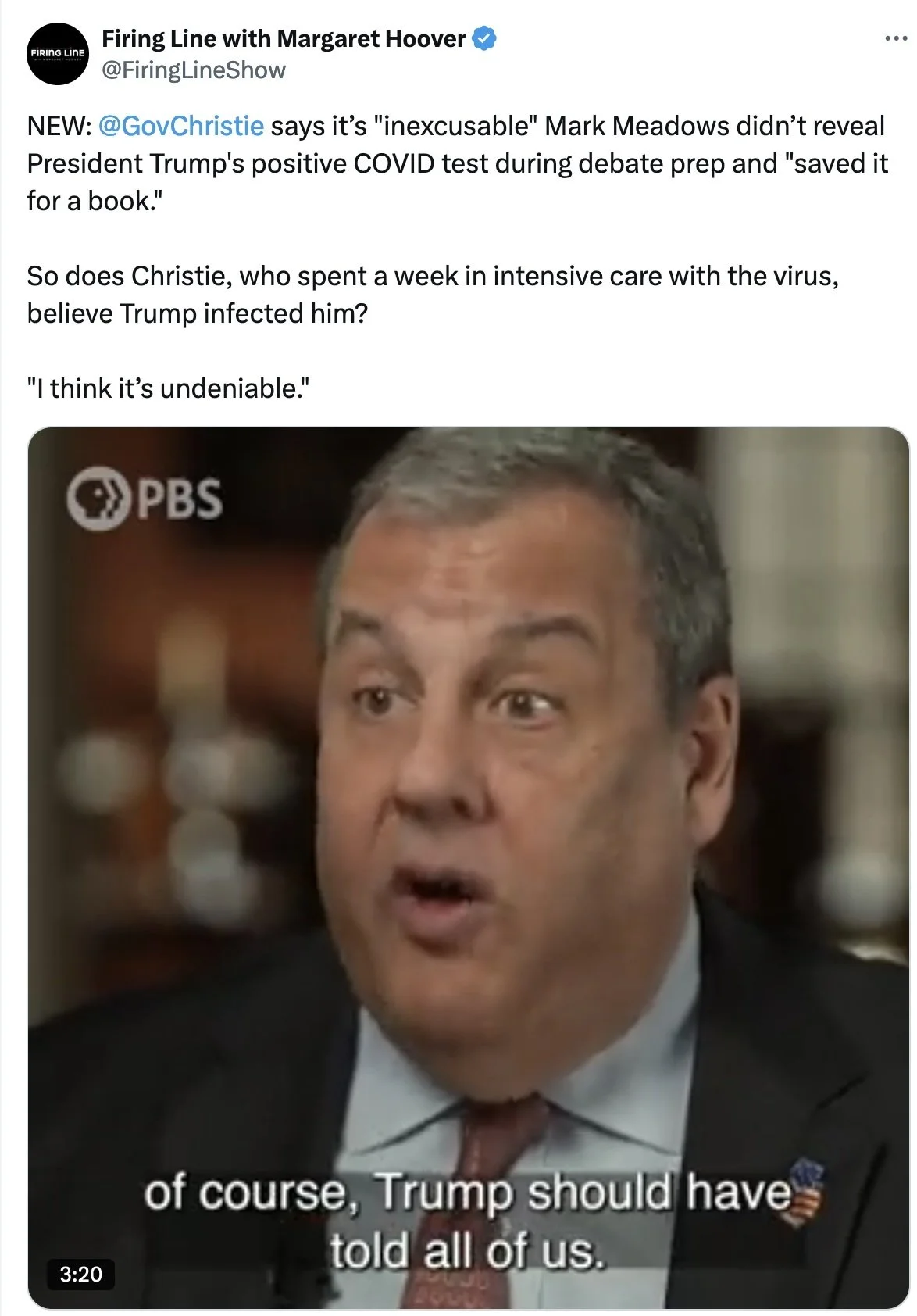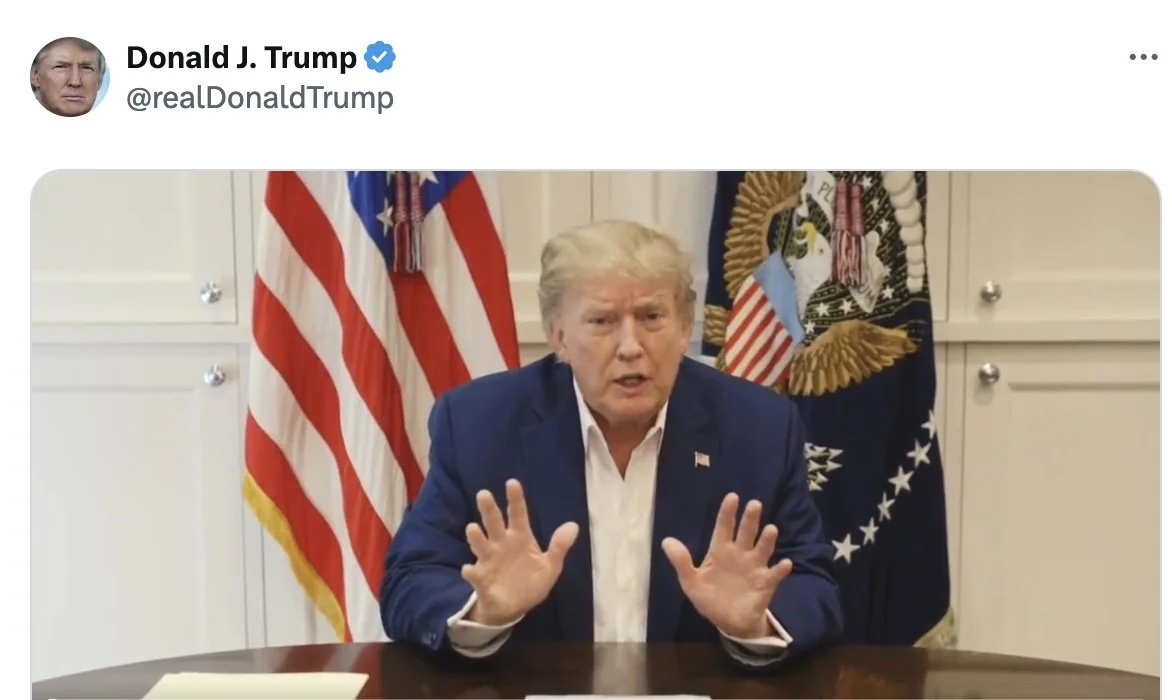The 2020October Surprise
Excerpt from The Trump Contagion: How Incompetence, Dishonesty, and Neglect Led to the Worst-Handled Crisis in American History.
October 2020 began with a surprise. At 12:54 am Eastern time on Friday, October 2, President Donald Trump tweeted:
“Tonight, @FLOTUS and I tested positive for COVID-19. We will begin our quarantine and recovery process immediately. We will get through this TOGETHER!”
This tweet was a lie.
Trump had in fact tested positive. But not that night. Or at least, not only that night. He had tested positive six days earlier, on Saturday, September 26, just after an outdoor Rose Garden ceremony announcing the nomination of Amy Comey Barrett to the U.S. Supreme Court. No one had been masked, and there was no social distancing. The event was later dubbed a COVID-19 super-spreader.
Trump’s Chief of Staff, Mark Meadows, broke the news to the president. Under CDC protocols, Trump should have self-isolated. But he continued with his scheduled activities, unmasked, and did not disclose his positive status. Neither did Meadows.
That day and for the next three days Trump prepared for his Tuesday televised debate with Joe Biden. That prep also became a super-spreader. Five of the six participants who spent those four days preparing Trump for the debate came down with COVID-19 afterward. One was former New Jersey Governor Chris Christie, who was diagnosed on October 3 and who was then hospitalized and in intensive care.
Christie was interviewed on a public television program in 2021, four days after news reports about Meadows’ newly published book revealed that Trump had known that he had COVID-19 during the prep. Christie said that his hospitalization was serious, and that on the first few days it “was touch and go”: “It could have gone either way.”
Christie expressed anger at Trump, whom he considered a friend and who should have alerted Christie and the five others involved in debate prep about his condition. At the very least, Christie said, he would have worn a mask while close to Trump: “I was playing Joe Biden. I was sitting right across from him. And we had some very spirited disagreements during the debate prep. So saliva was flying back and forth… Look, he had an obligation to tell me, and so did Meadows.”
On Sunday, September 27, one day after his positive test, Trump hosted a reception for Gold Star families – families who lost a loved one in war – at the White House, putting all of them at risk. He later blamed the Gold Star families for his catching COVID-19.
On Tuesday, September 29, four days after first testing positive, Trump was scheduled to debate Joe Biden. Under the rules of the debate, both candidates were required to have received a negative test result at the venue or immediately before arrival. But Trump got to the venue too late and was not tested. His being on stage with Joe Biden, even while standing far apart, put Biden at risk of catching the virus. During the debate, asked about his criticism of mask-wearing, Trump said that he wore masks when needed, and added, “Tonight, as an example, everybody’s had a test, and you’ve had social distancing and all of the things that you have to.”
But Trump had not had a test. And he knew he was positive for COVID-19. But he was not wearing a mask, increasing the risk to all who were there. Trump then mocked Biden for wearing a mask in public: “I don’t wear masks like him. Every time you see him, he’s got a mask. He could be speaking 200 feet away and he shows up with the biggest mask I’ve ever seen.”
The day after the debate Trump traveled to Minnesota for a rally and met with state Republican leaders. He was unmasked the whole time. During the rally, one of Trump’s advisors, Hope Hicks, developed COVID-19 symptoms. She had been part of the team preparing Trump for the debate.
The following day he traveled to New Jersey for another fundraiser. The New York Times later reported that one person who was present said that Trump seemed lethargic and had been in contact with about 100 people. The New York Times also noted that in a Fox News interview and in a call with Iowa voters Trump had sounded raspy.
Just before 1:00 am on October 2, Trump tweeted that he and his wife had tested positive.
By late morning Trump had a high fever. His oxygen saturation levels were dangerously low. Trump was on supplemental oxygen.
That evening he was flown by helicopter to Walter Reed Military Medical Center. There he was given an experimental treatment for COVID-19 and the anti-viral drug Remdesivir.
That night his oxygen saturation again fell to dangerous levels. He was administered a steroid, dexamethasone, which a study had shown reduced COVID-19 deaths of patients receiving oxygen by 20 percent.
The next day Trump posted a brief video in which he said he was doing better. But Chief of Staff Mark Meadows told reporters outside of the hospital, “The president’s vitals over the last 24 hours were very concerning and the next 48 hours will be critical in terms of his care. We’re still not on a clear path to a full recovery.”
Trump was furious at Meadows for suggesting that Trump was sicker than the White House and his doctors had conveyed. He posted a Tweet saying he felt well. Five hours later he posted a video on Twitter in which he said he was feeling much better and thought he would be back soon.
On Sunday Trump took a surprise trip outside the hospital, riding as a passenger in a presidential SUV, for a slow cruise around the hospital grounds, ostensibly to thank supporters who had begun to camp out near the grounds. The New York Times described the purpose of the trip as an attempt to dispel the perception of weakness and his determination to reassert himself on the political stage on his third day in the hospital.
One attending physician at Walter Reed, not on Trump’s medical team, was outraged by the stunt. Dr. James Phillips tweeted, “Every single person in the vehicle during that completely unnecessary Presidential ‘drive-by’ just now has to be quarantined for 14 days. They might get sick. They may die. For political theater. Commanded by Trump to put their lives at risk for theater. This is insanity.”
The next day, Monday, October 5, Trump was released from the hospital. He tweeted at about 2:37 pm: “I will be leaving the great Walter Reed Medical Center today at 6:30. Feeling really good! Don’t be afraid of Covid. Don’t let it dominate your life… I’m feeling better than I did 20 years ago!”
Trump returned to the White House that evening, wearing a mask on the Marine One helicopter. He stepped onto the balcony overlooking the South Lawn. He stood before the television cameras. He took off his mask and put it in his pocket. He then gave a military salute.
Commentators worried that his tweet and the maskless photograph would cast the impression among his followers that COVID-19 was not something to worry about. CNN called it reckless, and referred to it as, “… a remarkable attempt to convert his still-ongoing disease into a show of strength, even as it underscored his longstanding practice of denying the pandemic’s severity and downplaying its risks despite the more than 200,000 Americans dead.”
CNN also reminded viewers that Trump had received medical care that included experimental treatments that are unavailable to others. This included his receiving four doses of Remdesivir, which at the time fewer than a dozen Americans outside of clinical trials had been allowed to take.
Trump returned to the Oval Office two days after returning to the White House. On Saturday, October 10, eight days after being rushed to Walter Reed, Trump gave a speech to 2,000 supporters gathered on the South Lawn.
He resumed campaigning on Monday, October 12, ten days after disclosing that he had become infected. By that day, more than 215,000 Americans had died of COVID-19.







